The Smokehouse Associates: William T. Williams, Melvin Edwards, and Guy Ciarcia in Conversation with Eric Booker
09.23.2022

Zoom
To celebrate the publication of Smokehouse Associates, original members of the artist collective join the editor, Studio Museum Assistant Curator & Exhibition Coordinator Eric Booker, for a conversation delving into the group’s participatory, environmental, and abstract outdoor work.
From 1968 to 1970, the Smokehouse Associates transformed Harlem with vibrant, community-oriented, abstract murals and sculptures. Established by William T. Williams with Melvin Edwards, Guy Ciarcia, and Billy Rose, Smokehouse grew to encompass a range of creative practitioners united around the revolutionary potential of public art. Though relatively unknown today, Smokehouse was ambitious in its scale, community engagement, and interaction with the built environment. Smokehouse Associates provides the first critical examination of the group’s work, expanding the narrative of public art and social practice in the United States to include the contributions of artists of African descent. Preorder the book here.
smokehouse bios and headshots

William T. Williams
Known for his bold color and dynamic compositions, William T. Williams (b. 1942, Cross Creek, NC) has been committed to abstraction for more than fifty years. An alumnus of Pratt Institute, Yale University, and the Skowhegan School of Painting and Sculpture, Williams has cultivated a process-based approach to painting that synthesizes autobiographical reference, social narrative, and formal motifs sourced from specific cultural histories of the American South as well as New York. The recipient of numerous awards of distinction such as three artist grants from the National Endowment for the Arts (1965, 1970, 1994), Williams has garnered critical and institutional attention throughout his career. He has continually sought to engage his communities in dialogues about art through various undertakings, including a forty-year teaching career, initiation of the Artists-in-Residence program at The Studio Museum in Harlem, and his founding of the Smokehouse Associates. Williams is represented by Michael Rosenfeld Gallery.

Melvin Edwards
The work of Melvin Edwards (b. 1937, Houston, TX) reflects his engagement with the history of race, labor, and violence, as well as with themes of the African Diaspora. From colorful painted sculptures, barbed-wire installations, and tangled amalgamations of agricultural and industrial elements, his work is distinguished by its formal simplicity and powerful materiality. Shortly after he received his BFA from University of Southern California in 1965, the Santa Barbara Museum of Art organized his first solo exhibition, launching his professional career. After he moved to New York City in 1967, his work was exhibited at The Studio Museum in Harlem, and in 1970, he became the first African American sculptor to have a solo exhibition at the Whitney Museum of American Art. Edwards is represented by Alexander Gray Associates, New York, and Stephen Friedman Gallery, London.

Guy Ciarcia
Guy Ciarcia’s (b. 1942, Union City, NJ) artistic practice is rooted in principles of the Italian Renaissance, classical Greek art, and formalism. He attended Pratt Institute, New York University, and the Accademia di Belle Arti in Florence, Italy. Spanning more than fifty years, his expansive body of work encompasses painting, murals, photography, film, digital drawings, sculpture, ceramics, crafts, and jewelry. Ciarcia received early recognition for his contributions as a member of the Smokehouse Associates in the late 1960s. His work has been exhibited at many institutions, including the Jewish Museum, New York (1970); New Jersey State Museum, Trenton (1969); Philadelphia Museum of Art (1969); and Smithsonian Institution, Washington, DC (1988). He has taught in the Trenton, New Jersey, school system for twenty-five years. Ciarcia has received grants from the Museum of Modern Art and the New Jersey State Council on the Arts in Mercer County.

Eric Booker
Eric Booker is Assistant Curator and Exhibition Coordinator at The Studio Museum in Harlem.
Smokehouse Artworks

William T. Williams, Trane (1969)

William T. Williams, Untitled (1969)

Melvin Edwards, Cotton Hangup (1966)
Smokehouse Resources
Smokehouse
Black Refractions | Highlights from The Studio Museum in Harlem
Smokehouse
A Constellation
The Smokehouse Painters
Harlem’s Smokehouse Collective Wanted to Heal With Abstraction
Smokehouse funders credits
Support for inHarlem public programming provided by the Institute of Museum and Library Services. The Studio Museum in Harlem’s digital programs are supported by the Helen Frankenthaler Foundation’s Frankenthaler Digital Initiative. Additional support has been provided by the New York City Department of Cultural Affairs and the New York State Council on the Arts with the support of the Office of the Governor and the New York State Legislature. The Smokehouse Associates publication was made possible thanks to funding from the Graham Foundation for Advanced Studies in the Fine Arts and Terra Foundation for American Art
The Smokehouse Associates: William T. Williams, Melvin Edwards, and Guy Ciarcia in Conversation with Eric Booker
09.23.2022

Zoom
To celebrate the publication of Smokehouse Associates, original members of the artist collective join the editor, Studio Museum Assistant Curator & Exhibition Coordinator Eric Booker, for a conversation delving into the group’s participatory, environmental, and abstract outdoor work.
From 1968 to 1970, the Smokehouse Associates transformed Harlem with vibrant, community-oriented, abstract murals and sculptures. Established by William T. Williams with Melvin Edwards, Guy Ciarcia, and Billy Rose, Smokehouse grew to encompass a range of creative practitioners united around the revolutionary potential of public art. Though relatively unknown today, Smokehouse was ambitious in its scale, community engagement, and interaction with the built environment. Smokehouse Associates provides the first critical examination of the group’s work, expanding the narrative of public art and social practice in the United States to include the contributions of artists of African descent. Preorder the book here.
smokehouse bios and headshots

William T. Williams
Known for his bold color and dynamic compositions, William T. Williams (b. 1942, Cross Creek, NC) has been committed to abstraction for more than fifty years. An alumnus of Pratt Institute, Yale University, and the Skowhegan School of Painting and Sculpture, Williams has cultivated a process-based approach to painting that synthesizes autobiographical reference, social narrative, and formal motifs sourced from specific cultural histories of the American South as well as New York. The recipient of numerous awards of distinction such as three artist grants from the National Endowment for the Arts (1965, 1970, 1994), Williams has garnered critical and institutional attention throughout his career. He has continually sought to engage his communities in dialogues about art through various undertakings, including a forty-year teaching career, initiation of the Artists-in-Residence program at The Studio Museum in Harlem, and his founding of the Smokehouse Associates. Williams is represented by Michael Rosenfeld Gallery.

Melvin Edwards
The work of Melvin Edwards (b. 1937, Houston, TX) reflects his engagement with the history of race, labor, and violence, as well as with themes of the African Diaspora. From colorful painted sculptures, barbed-wire installations, and tangled amalgamations of agricultural and industrial elements, his work is distinguished by its formal simplicity and powerful materiality. Shortly after he received his BFA from University of Southern California in 1965, the Santa Barbara Museum of Art organized his first solo exhibition, launching his professional career. After he moved to New York City in 1967, his work was exhibited at The Studio Museum in Harlem, and in 1970, he became the first African American sculptor to have a solo exhibition at the Whitney Museum of American Art. Edwards is represented by Alexander Gray Associates, New York, and Stephen Friedman Gallery, London.

Guy Ciarcia
Guy Ciarcia’s (b. 1942, Union City, NJ) artistic practice is rooted in principles of the Italian Renaissance, classical Greek art, and formalism. He attended Pratt Institute, New York University, and the Accademia di Belle Arti in Florence, Italy. Spanning more than fifty years, his expansive body of work encompasses painting, murals, photography, film, digital drawings, sculpture, ceramics, crafts, and jewelry. Ciarcia received early recognition for his contributions as a member of the Smokehouse Associates in the late 1960s. His work has been exhibited at many institutions, including the Jewish Museum, New York (1970); New Jersey State Museum, Trenton (1969); Philadelphia Museum of Art (1969); and Smithsonian Institution, Washington, DC (1988). He has taught in the Trenton, New Jersey, school system for twenty-five years. Ciarcia has received grants from the Museum of Modern Art and the New Jersey State Council on the Arts in Mercer County.

Eric Booker
Eric Booker is Assistant Curator and Exhibition Coordinator at The Studio Museum in Harlem.
Smokehouse Artworks

William T. Williams, Trane (1969)

William T. Williams, Untitled (1969)

Melvin Edwards, Cotton Hangup (1966)
Smokehouse Resources
Smokehouse
Black Refractions | Highlights from The Studio Museum in Harlem
Smokehouse
A Constellation
The Smokehouse Painters
Harlem’s Smokehouse Collective Wanted to Heal With Abstraction
Smokehouse funders credits
Support for inHarlem public programming provided by the Institute of Museum and Library Services. The Studio Museum in Harlem’s digital programs are supported by the Helen Frankenthaler Foundation’s Frankenthaler Digital Initiative. Additional support has been provided by the New York City Department of Cultural Affairs and the New York State Council on the Arts with the support of the Office of the Governor and the New York State Legislature. The Smokehouse Associates publication was made possible thanks to funding from the Graham Foundation for Advanced Studies in the Fine Arts and Terra Foundation for American Art
Zoom